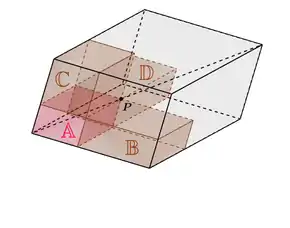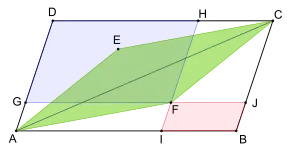
Theorem of the Gnomon: green area = red area,
The theorem of the gnomon states that certain parallelograms occurring in a gnomon have areas of equal size.
Theorem
In a parallelogram with a point on the diagonal , the parallel to through intersects the side in and the side in . Similarly the parallel to the side through intersects the side in and the side in . Then the theorem of the gnomon states that the parallelograms and have equal areas.[1][2]
Gnomon is the name for the L-shaped figure consisting of the two overlapping parallelograms and . The parallelograms of equal area and are called complements (of the parallelograms on diagonal and ).[3]
Proof
The proof of the theorem is straightforward if one considers the areas of the main parallelogram and the two inner parallelograms around its diagonal:
- first, the difference between the main parallelogram and the two inner parallelograms is exactly equal to the combined area of the two complements;
- second, all three of them are bisected by the diagonal. This yields:[4]
Applications and extensions


The theorem of the gnomon can be used to construct a new parallelogram or rectangle of equal area to a given parallelogram or rectangle by the means of straightedge and compass constructions. This also allows the representation of a division of two numbers in geometrical terms, an important feature to reformulate geometrical problems in algebraic terms. More precisely, if two numbers are given as lengths of line segments one can construct a third line segment, the length of which matches the quotient of those two numbers (see diagram). Another application is to transfer the ratio of partition of one line segment to another line segment (of different length), thus dividing that other line segment in the same ratio as a given line segment and its partition (see diagram).[1]

A similar statement can be made in three dimensions for parallelepipeds. In this case you have a point on the space diagonal of a parallelepiped, and instead of two parallel lines you have three planes through , each parallel to the faces of the parallelepiped. The three planes partition the parallelepiped into eight smaller parallelepipeds; two of those surround the diagonal and meet at . Now each of those two parallelepipeds around the diagonal has three of the remaining six parallelepipeds attached to it, and those three play the role of the complements and are of equal volume (see diagram).[2]
General theorem about nested parallelograms

green area = blue area - red area
The theorem of gnomon is special case of a more general statement about nested parallelograms with a common diagonal. For a given parallelogram consider an arbitrary inner parallelogram having as a diagonal as well. Furthermore there are two uniquely determined parallelograms and the sides of which are parallel to the sides of the outer parallelogram and which share the vertex with the inner parallelogram. Now the difference of the areas of those two parallelograms is equal to area of the inner parallelogram, that is:[2]
This statement yields the theorem of the gnomon if one looks at a degenerate inner parallelogram whose vertices are all on the diagonal . This means in particular for the parallelograms and , that their common point is on the diagonal and that the difference of their areas is zero, which is exactly what the theorem of the gnomon states.
Historical aspects
The theorem of the gnomon was described as early as in Euclid's Elements (around 300 BC), and there it plays an important role in the derivation of other theorems. It is given as proposition 43 in Book I of the Elements, where it is phrased as a statement about parallelograms without using the term "gnomon". The latter is introduced by Euclid as the second definition of the second book of Elements. Further theorems for which the gnomon and its properties play an important role are proposition 6 in Book II, proposition 29 in Book VI and propositions 1 to 4 in Book XIII.[5][4][6]
References
- Lorenz Halbeisen, Norbert Hungerbühler, Juan Läuchli: Mit harmonischen Verhältnissen zu Kegelschnitten: Perlen der klassischen Geometrie. Springer 2016, ISBN 9783662530344, pp. 190–191 (German)
- George W. Evans: Some of Euclid's Algebra. The Mathematics Teacher, Vol. 20, No. 3 (March 1927), pp. 127–141 (JSTOR)
- William J. Hazard: Generalizations of the Theorem of Pythagoras and Euclid's Theorem of the Gnomon. The American Mathematical Monthly, Vol. 36, No. 1 (January 1929), pp. 32–34 (JSTOR)
- Paolo Vighi, Igino Aschieri: From Art to Mathematics in the Paintings of Theo van Doesburg. In: Vittorio Capecchi, Massimo Buscema, Pierluigi Contucci, Bruno D'Amore (editors): Applications of Mathematics in Models, Artificial Neural Networks and Arts. Springer, 2010, ISBN 9789048185818, pp. 601–610
Notes
- 1 2 Lorenz Halbeisen, Norbert Hungerbühler, Juan Läuchli: Mit harmonischen Verhältnissen zu Kegelschnitten: Perlen der klassischen Geometrie. Springer 2016, ISBN 9783662530344, pp. 190-191
- 1 2 3 William J. Hazard: Generalizations of the Theorem of Pythagoras and Euclid's Theorem of the Gnomon. The American Mathematical Monthly, volume 36, no. 1 (Jan., 1929), pp. 32–34 (JSTOR)
- ↑ Johannes Tropfke: Geschichte der Elementarmathematik Ebene Geometrie – Band 4: Ebene Geometrie. Walter de Gruyter, 2011, ISBN 9783111626932, pp. 134-135 (German)
- 1 2 Roger Herz-Fischler: A Mathematical History of the Golden Number. Dover, 2013, ISBN 9780486152325, pp.35–36
- ↑ Paolo Vighi, Igino Aschieri: From Art to Mathematics in the Paintings of Theo van Doesburg. In: Vittorio Capecchi, Massimo Buscema, Pierluigi Contucci, Bruno D'Amore (editors): Applications of Mathematics in Models, Artificial Neural Networks and Arts. Springer, 2010, ISBN 9789048185818, pp. 601–610, in particular pp. 603–606
- ↑ George W. Evans: Some of Euclid's Algebra. The Mathematics Teacher, Volume 20, no. 3 (March, 1927), pp. 127–141 (JSTOR)